

Turner - Grand Canal in Venice
Yuzo Saeki in Paris
Victory(Nike) of Samothrace
Starry Night Over the Rhone of Gogh
Water Lilies of Monet
Still Life Of Cezanne
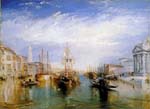
The Grand Canal, Venice - 1835
Oil on canvas, 91.4 x 122.2 cm
The Metropolitan Museum of Art, New York
This time I introduce a painting of Turner. I have an image of strong waves about Turner. But when I saw this painting at Metropolitan Museum, I was surprised at quiet and beautiful painting of harbor. Clouds reflect bright light and it express shining light of sun excellently.
Turner, John Mallord William
(1775-1851)
He was born in London, England, on April 23, 1775. He is one of the finest landscape artists, whose work was exhibited when he was still a teenager.Venice was the inspiration of some of Turner's finest work. Wherever he visited he studied the effects of sea and sky in every kind of weather.
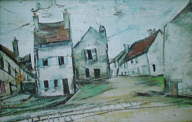 |
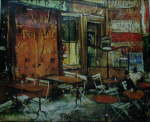 |
| Landscape of Moran 1928 |
Restaurant (Hotel de Marche) 1927 |
This time I introduce paintings of Yuzo Saeki. His paintings are like Utrillo's. They have quiet mood and he is also my favorite painter. Once I have seen his works that he painted in Japan. Those paintings are totally different from ones in Paris. I believe that many Japanese painters in those days went to Paris because they were looking for subjects there.
Yuzo Saeki
(April 28, 1898 - August 16, 1927)
He was born in Osaka in Japan. He went to France in 1923 and was impressed on Gogh. He returned to Japan in 1926 for a while and went to France again in 1927. Next year he died in Paris. He was influenced by Vlaminck and Utrillo.
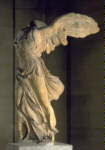
"Victory(Nike) of Samothrace"
Samothrace (island in the North Aegean Sea)
Circa 190 BC
H 328 cm (including the wings)
This time I will introduce a statue. I was overwhelmed by its beauty when I saw it for the first time.
The Goddess stood on the prow of a ship looks quite vivid enjoying wind and splash. Flow of a wind appears on the clothes, that seems so soft as if it is not a marble statue. I believe wings make its beauty perfect.
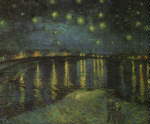
Vincent Van Gogh : Starry Night Over the Rhone - September, 1888, Arles
Paris, Museum d'Orsay
I have never seen the beautiful sky with falling stars like this. I love it making me mysterious mood.
The most favorite painting of Gogh is "The Cafe Terrace on the Place du Forum, Arles, at Night". (But as the title is very long, I call it "A restaurant with view of stars".) Stars in this painting also shine brightly. I feel as if the stars present an everlasting universe over the time.
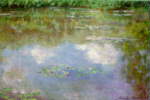
Claude Monet : Water Lilies (The Clouds) - 1903
Oil on canvas, 29 3/8 x 41 7/16 in.
Private Collection
It is located in the Japanese Garden that Monet built in his house. I feel that Monet loved this garden very much. It is not only the original scenary familiar to Japanese, but it also has a taste different from Japanese paintings. I can regard it as the reimport of culture, where Japanese can recognize the beauty of Japanese scenary again.
In his final years he was troubled by failing eyesight, but he painted until the end. He was enormously prolific and many major galleries have examples of his work.
(WebMuseum : Monet, Claude)
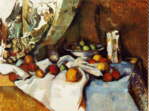
Paul Cezanne : Still Life with Apples, 1895-98
Oil on canvas, 27 x 36.5 in.
The Museum of Modern Art, New York
An apple reminds me Cezanne. At first look, this painting looks like ordinary still life. But I can find "cube" here, there and everywhere in it. A postcard of this painting in an architrave is hung next to the washstand in my house.
 Return
Return